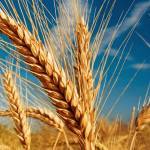Beyond Bran: Other Wheat Byproducts for Horses

Wheat bran is often fed to horses in a warm mash, but horse owners may not be as familiar with other byproducts of wheat milling. Wheat byproducts were an integral part of the beginning of the feed industry. Many of the earliest feed companies were flour milling companies looking for an outlet for their byproducts. Since wheat byproducts are so important to the feed industry, it is essential that proper terminology be used to differentiate between the various types of byproducts.
Wheat bran is the coarse outer covering of the wheat kernel that is separated from cleaned and scoured wheat in the usual process of commercial milling. Wheat middlings, known also as wheat midds, refers to the fine particles of wheat bran, wheat shorts, wheat germ, and wheat flour produced in the milling process. Wheat midds must be obtained in the usual process of commercial milling and must contain no more than 9.5% crude fiber. Wheat mill run is similar to wheat midds but tends to contain somewhat coarser grades of the same ingredients. These terms are often used interchangeably, but the actual byproducts are not the same.
When flour is milled from wheat, the amount of outer covering removed is determined by the quality of the flour desired as a final product. As flour purity increases, yield decreases. The degree of milling that occurs is dictated by the marketplace, both the prices of various grades of flour and the price of byproducts. For example, if the market price for bran is high and either the demand for, or the price of, midds is low, the milling process can be adjusted so that more of the starchy endosperm will be diverted into the bran fraction.
Wheat is broadly classified by agronomic and utilization criteria. Hard wheat varieties are generally grown in medium temperate zones with lower rainfall. Hard wheat has small, hard berries and moderately strong gluten (wheat protein). Soft wheats have larger kernels and are found in milder climates with more rainfall. Winter wheats are planted in the fall while spring wheats are planted in the spring. The resulting varieties are numerous: hard red spring, hard red winter, soft white spring, and so on.
Because of varietal differences, the nutrient composition of wheat tends to be more variable than any other grain, especially with respect to protein content. Hard wheats are generally highest in protein. The endosperm makes up almost 83% of the kernel and contains 73% of the total protein. Bran is about 14% of the kernel and contains 19% of the total protein. The germ makes up the remaining 3% of the kernel and contains 8% of the total protein. The majority of the vitamin content is in the bran. Perhaps the most attractive aspect of wheat byproducts as a feedstuff is the relatively high protein content: 17.5% in bran, 18.5% in midds, and 17.3% in mill run.
Wheat midds can be used as an ingredient in horse feeds. This byproduct is energy dense (around 3 Mcal/kg), which is much higher than forage (1.5-2.2 Mcal/kg). The form of the energy is relevant as wheat midds are much higher in starch (around 25%) than hay. The byproduct also contains more phosphorus than calcium. If a large amount is included in a horse’s ration, more calcium needs to be fed to keep the calcium:phosphorus ratio in balance.
Moisture is one of the major considerations in maintaining the quality of wheat byproducts. Wheat is tempered to between 17% and 19% moisture prior to milling to improve the efficiency of the milling process. Byproducts are often stored at this higher moisture content and if not properly managed, will heat up and begin to sour and mold rather quickly. Some flour mills are pelleting their midds and mill run to help stabilize the byproduct and to improve storage, shipping, and handling characteristics.








